Your lead gen strategy is either helping you scale or it’s holding you back.
Manual processes, static targeting, and one-size-fits-all outreach won’t deliver results in a data-driven market. AI lead generation flips the script.
AI lead generation uses AI for sales to automatically identify, attract, qualify, and nurture business leads across digital channels. These AI sales tools capture data and interpret it to make decisions in real time. The result is improved lead quantity and quality, with reduced workload on your sales and marketing teams.
According to Forbes, 83% of sales teams using AI lead generation see revenue growth. No wonder 81% of sales teams now invest in AI lead gen.
Let’s see why you should, too. But first, let’s quickly learn what these systems are.
Leverage AI lead generation with Lyro AI Agent
How AI-based lead generation works
AI-powered lead generation tools work by using three smart technologies. First, they rely on machine learning, which learns from how leads behave and keeps getting better over time. Then there’s predictive analytics. This looks at past and real-time data to guess which leads are most likely to turn into customers.
Finally, natural language processing helps these AI sales tools understand and write text that sounds human, so messages feel more personal. Together, these tools make lead generation faster, smarter, and more effective.
In fact, Salesforce’s recent State of Sales Report found that 68% of sales professionals say AI helps them improve lead gen and makes it more cost-effective.
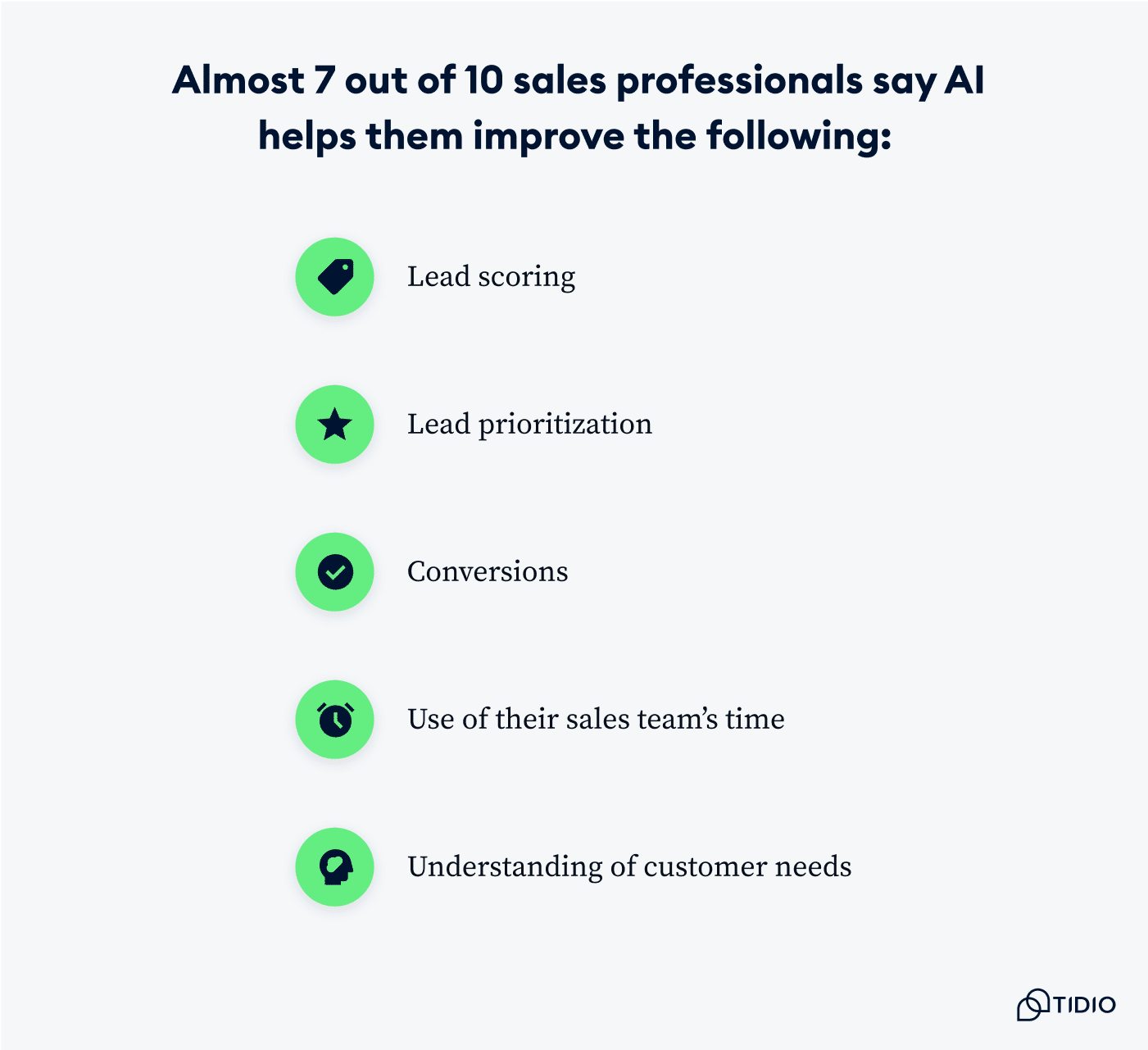
But how does AI lead generation help sales? Here’s what AI lead generation tools do:
- Track intent signals: Monitor behaviors like repeat visits, time on key pages, button clicks, form abandonment, etc.
- Score leads automatically: Assigns real-time scores based on behavioral triggers, firmographics, and previous interactions.
- Personalize outreach: Send messages at the right time, with the right content, using the right channel, all based on user data.
AI lead generation systems run 24/7, continuously learning and optimizing outreach. This would be extremely costly for a human team to match.
How AI lead generation differs from traditional methods
Traditional lead gen relies heavily on manual labor and guesswork. Using AI for sales adds precision and speed while enabling personalization at scale.
Traditional lead generation
Traditional outbound lead generation relies on manual outreach. Sales development reps spend time building lists, cold-calling, or sending the same email to everyone. With some luck, leads are then scored using basic details like company size, job title, or industry.
There’s really no actionable insight into how people actually behave.
The messaging is one-size-fits-all, with the same pitch sent to every prospect, no matter where they are in the sales journey. This approach often wastes time and misses the mark. The result? Poor conversion rates.
AI-powered lead generation
AI-powered lead generation is changing the way businesses find and connect with potential customers. It starts by grouping leads based on how they behave and what they’ve done before. Then, it scores those leads depending on what they click on, read, or do inside your CRM.
Messaging becomes smarter, too. Tailored to each person, their stage in the sales journey, and even the time they’re most likely to respond. AI agents work around the clock, asking the right questions, answering common ones, and ensuring the hottest leads immediately go where they need to.
Traditional vs. AI Lead Generation
| Feature | Traditional | AI-Powered |
| Outreach | Manual and batch-based | Automated and behavior-triggered |
| Lead Scoring | Static, rule-based | Dynamic, real-time, predictive |
| Personalization | Limited | High, based on behavior and context |
| Timing | Fixed schedule | Optimized based on user activity |
| Interactions | Delayed or missed | Real-time via chat or automated messaging |
Direct benefits of AI lead generation
AI is a major upgrade to traditional lead generation efforts, making the process faster and much more cost-effective. Multiple studies found that companies implementing AI in their sales processes saw:
- More than a 50% increase in lead generation
- A 60–70% reduction in call times
- A 40–60% reduction in costs
Now, let’s take a look at the key benefits of AI lead generation in more detail.
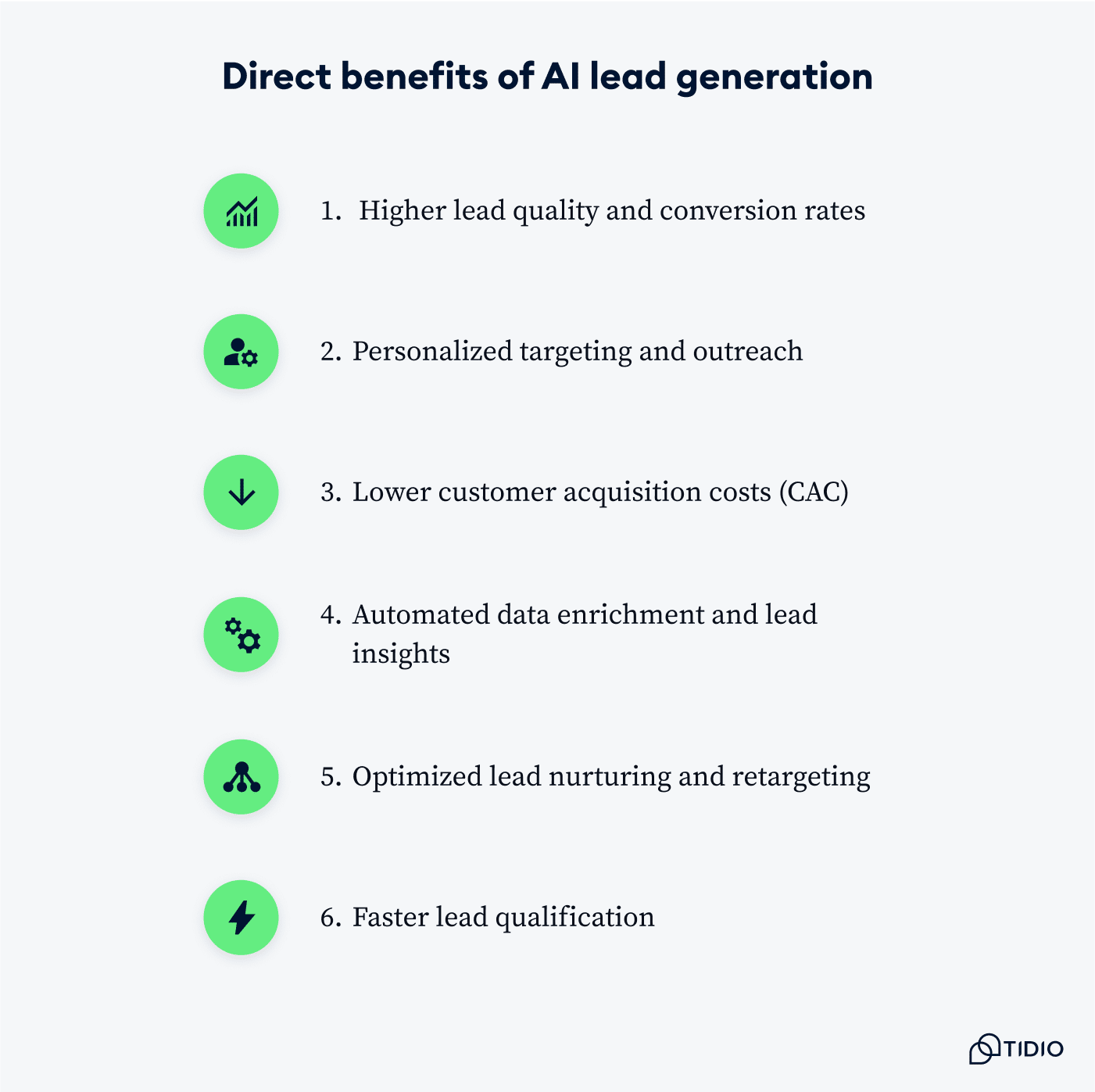
- Higher lead quality and conversion rates: AI helps find great leads by looking through lots of data. It uses this info to score leads better, fill in missing details, and group them smartly. That way, you can spot the right leads faster, and turn more of them into customers.
Here’s an example of Lyro AI agent catching a lead:
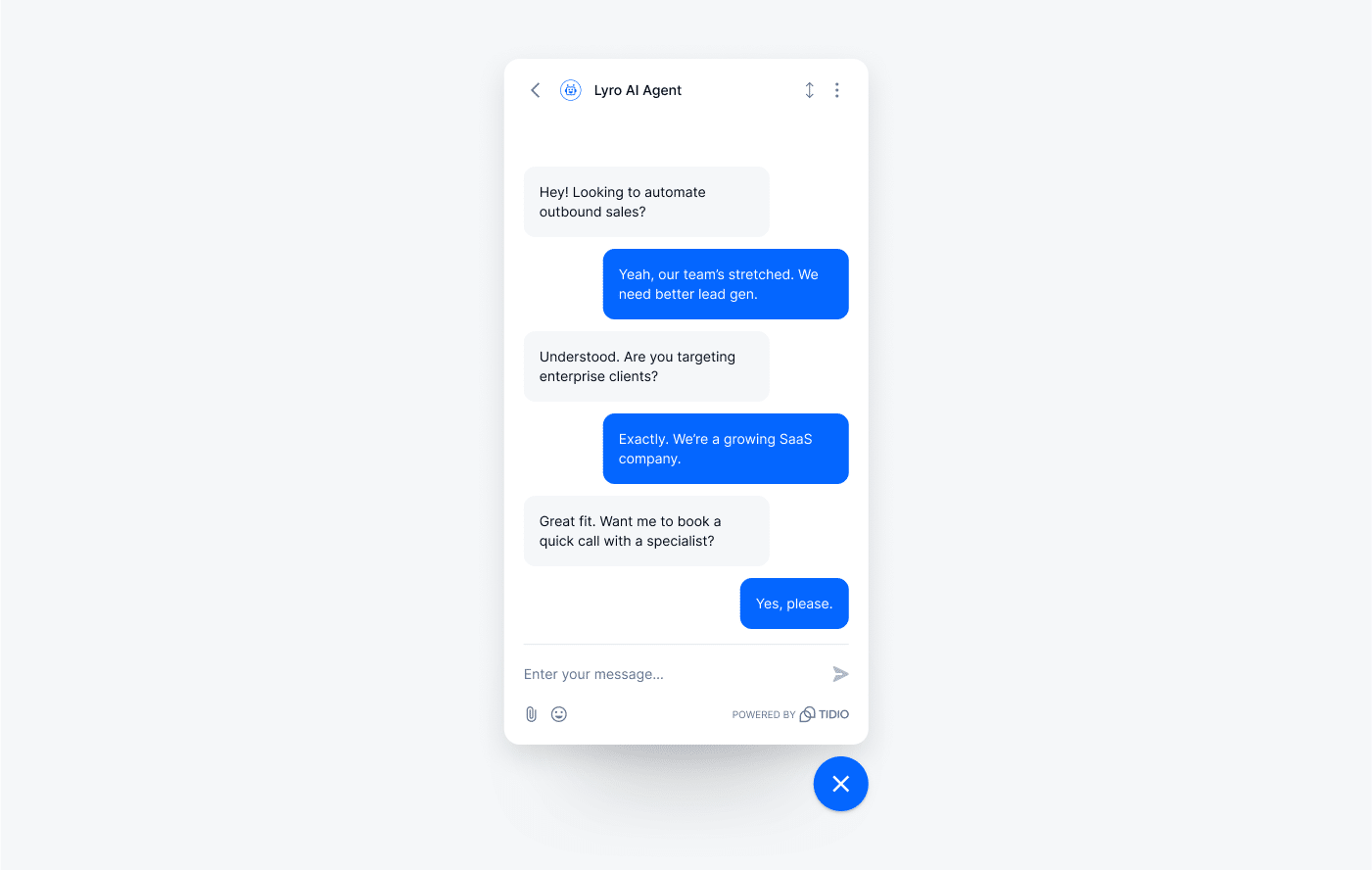
- Personalized targeting and outreach: AI looks at past data and what people do online right now. Then, it sends the right message to the right people. This means more replies, more interest, and more sales.
- Lower customer acquisition costs (CAC): AI optimizes marketing spend by finding and targeting high-intent leads while refining ad placements in real time, improving the likelihood of conversion.
- Automated data enrichment and lead insights: AI refines and updates lead data continuously using multiple sources. It does so even for APIs thanks to AI agents. This improves targeting and decision-making.
- Optimized lead nurturing and retargeting: Predictive analytics can determine the best time, channel, and content for lead nurturing and retargeting. It considers real-time changes and news events, for example, adapting outreach on the fly. Companies that excel at lead nurturing generate 50% more sales-ready leads at a 33% lower cost.
- Faster lead qualification: AI doesn’t just predict which leads are worth chasing. It can also talk to them in real time. Smart AI chatbots and AI agents can ask questions, spot interest, and decide who’s ready to buy. If someone ticks all the right boxes, they get passed straight to a sales rep.
A 6-step strategy for AI lead gen and AI for sales
AI isn’t a one-click fix. You need a smart lead generation strategy to extract real value. In fact, 61% of high-performing sales orgs now use AI to boost productivity and personalize outreach. But knowing AI can help and how to use it are two very different things.
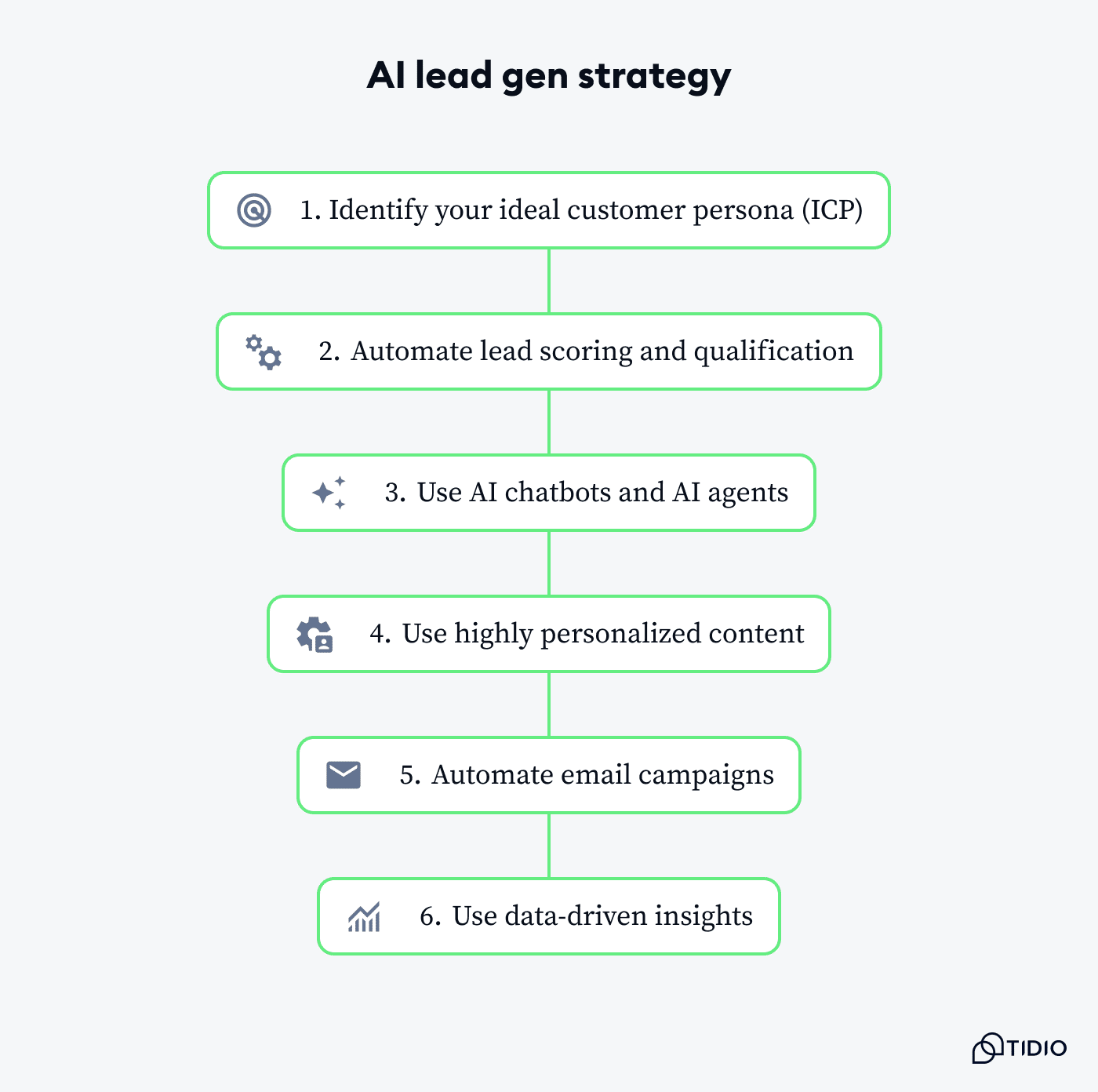
1. Identify your ideal customer persona (ICP)
AI needs a foundation to work from. The better you define your ICP, the more accurate your lead scoring and targeting will be.
- Use CRM software and past sales data to pinpoint common success factors.
- Segment by vertical, pain points, buying triggers, and journey length.
- Feed this data into your AI sales tools to create a focused scoring model.
Pro Tip: Regularly update your ICP every quarter. Buying patterns change. Your model should, too.
2. Automate lead scoring and qualification
Once you have your ICP, let AI do the grunt work of qualification.
- Assign point values to high-converting behaviors (e.g., visiting the pricing page = +10).
- Use predictive models to spot patterns in converted customers vs. non-converters.
- Set thresholds that notify your sales team when a lead is “sales-ready.”
Pro Tip: AI models can analyze negative signals too, like when someone unsubscribes, ignores multiple emails, or browses your career page (likely a job seeker, not a buyer).
3. Use AI-powered chatbots and AI agents
AI agents are lead capture machines. But you must set them up correctly.
- Place chatbots on high-conversion pages (pricing, demo, contact).
- Use pre-built playbooks to ask key qualifying questions (e.g., budget, decision timeline).
- Automate meeting scheduling or route to a live rep if the lead scores high enough.
Did you know that… Businesses using AI chatbots for lead generation can reduce lead response time from hours to seconds, improving qualification by up to 35%.
Lyro AI agent can instantly qualify, tag, and sync leads into your CRM, without a single manual step.
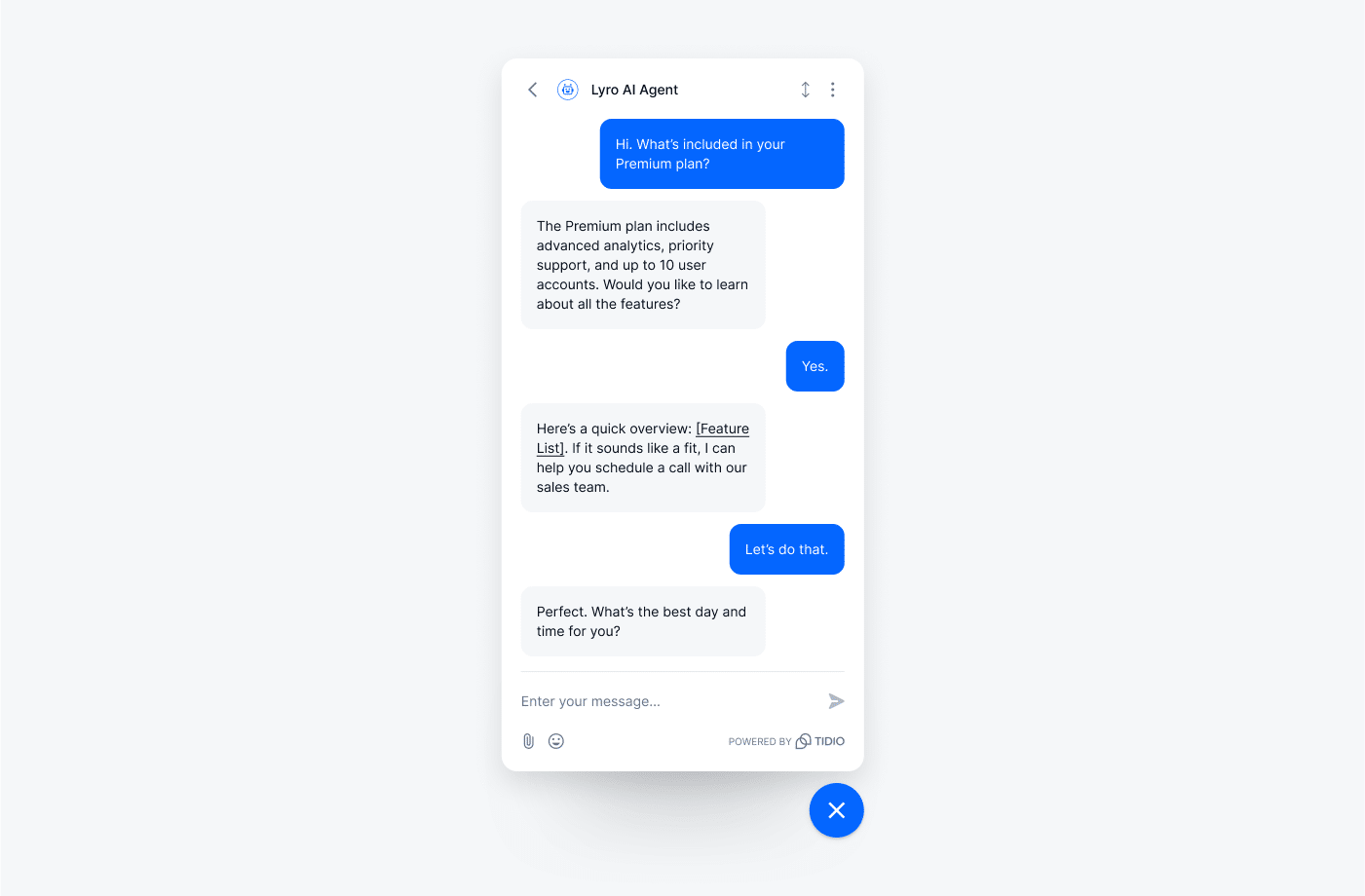
Automate your lead generation today with Tidio
4. Use highly personalized content
Relevance converts. AI sales tools help deliver content tailored to each lead’s interest and funnel stage.
- Generate blog summaries or webinar follow-ups based on what the lead read or watched.
- Show dynamic website banners depending on the traffic source or industry.
- Use tools that generate outbound email content based on persona, company news, or social activity.
Best practice: Build content triggers: “If watched X webinar, send Y use case email within 48 hours.” Let AI handle it from there.
5. Automate email campaigns to reach more leads
Email automation is driven by AI through personalization, scheduling, and optimizing email.
- Automatically adjust send times based on open history.
- Personalize subject lines using NLP that adapts to each lead’s language or tone preferences.
- Create drip campaigns that adjust based on click behavior and engagement score.
Example tactic: If a lead clicks “See pricing” but doesn’t sign up, AI can trigger a follow-up that breaks down cost-benefit ROI with social proof and a CTA to book a call.
6. Use data-driven insights to optimize lead gen
AI sales tools generate leads while telling you why leads convert.
- Monitor KPIs like CPL, MQL-to-SQL conversion rate, and revenue per lead.
- Identify the highest-converting content and channels using AI attribution modeling.
- Use this data to double down on what works and cut what doesn’t.
Important: Don’t just look at open rates. Track revenue metrics like pipeline influenced, not just surface-level engagement.
Common mistakes to avoid with AI lead generation
Too many businesses invest in AI tools but see poor results. Why? Because they skip the strategy.
A Forbes report reveals that 94% of companies are increasing their AI investments, yet many struggle to implement these tools effectively. Only 21% have fully embedded AI into their operations.
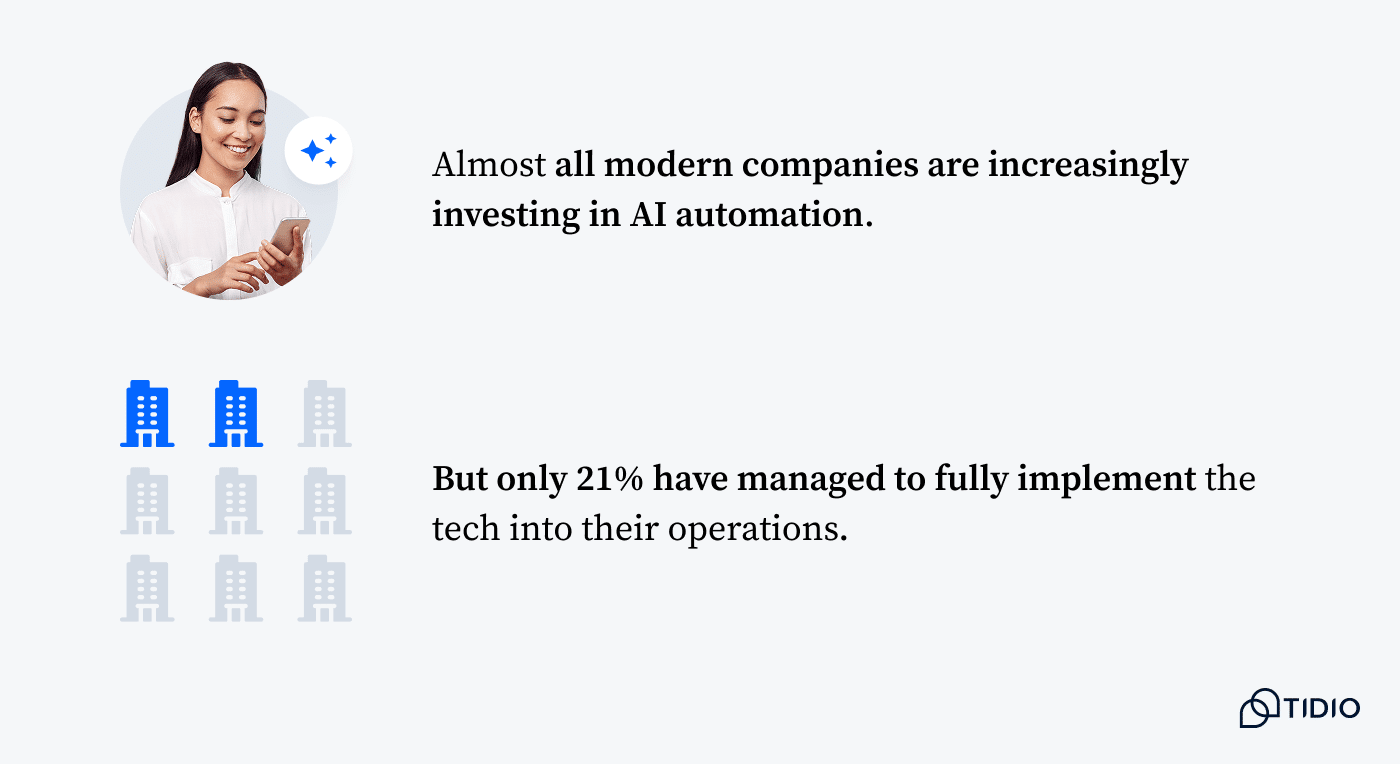
The gap between ambition and execution is wide. Without a clear plan, AI becomes just another expense.
Here are the top mistakes to avoid:
- Jumping in without clean data: AI is only as good as the data it trains on. Dirty CRM records or inconsistent tracking will derail your results. You should:
- Standardize contact fields
- Remove duplicates
- Sync data across marketing, sales, and support systems
- Failing to train your AI model: Don’t rely on out-of-the-box settings. Train the system using past conversion data, email replies, and user journeys.
- Over-automating communication: Too many automated messages can hurt trust. Use AI for timing and personalization, but keep the messaging human and value-driven.
- Ignoring the sales team: If AI scores a lead as hot but sales doesn’t act on it, it’s wasted. Make sure sales understands how AI scoring works, as well as trusts it.
Pro Tip: Build a feedback loop. Let reps flag incorrectly scored leads so AI models can improve over time.
Real-world examples: how AI lead gen tools boost revenue
To really see what AI lead generation can do, it helps to look at real examples. The stories below show how companies use Tidio’s tools to catch more leads and deploy AI in sales in a smart yet cost-effective way.
Here are three quick examples of how it makes a difference.
Integratec boosts qualified lead generation by 25% using Tidio
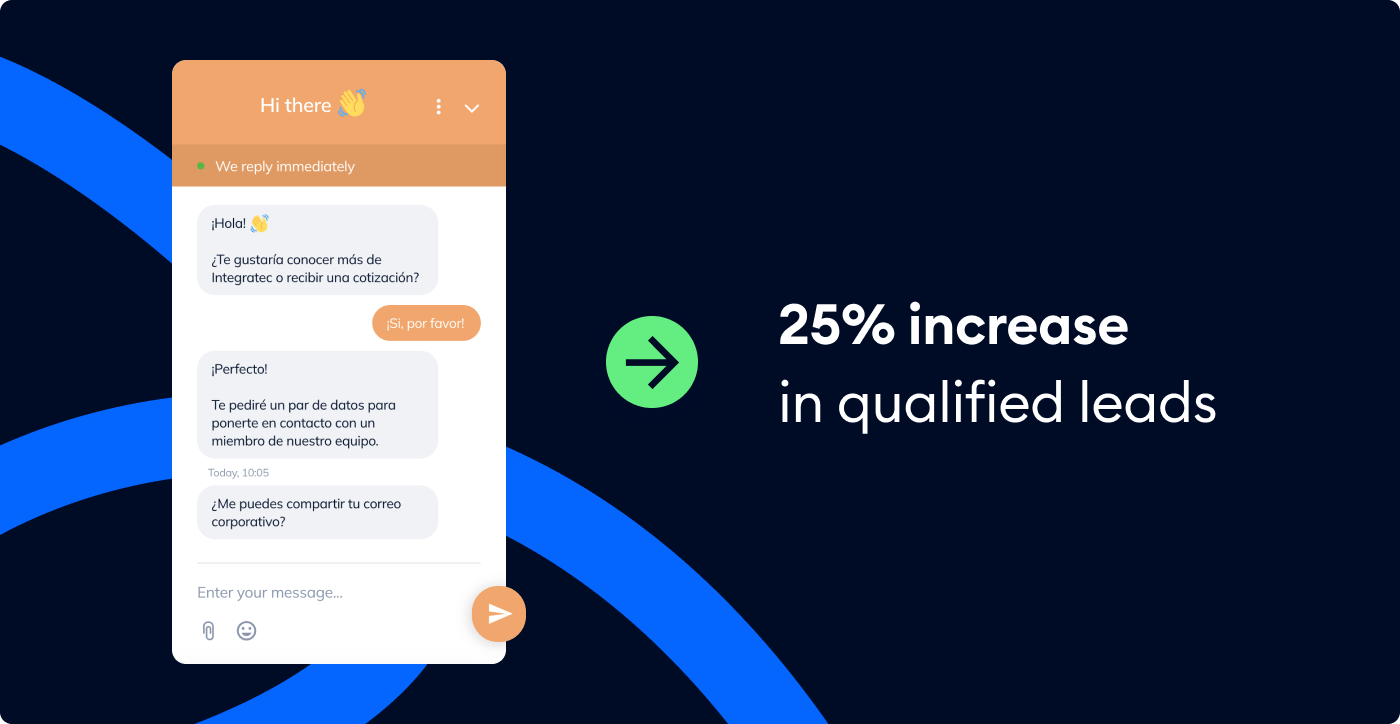
Before using Tidio, Integratec relied on a basic contact form that left potential leads hanging for hours. As a result, they were missing out on key sales opportunities in a highly competitive B2B tech market.
In the sales department, there was around a 25% increase in qualified leads from our website chat.

To improve engagement, Integratec implemented Tidio’s live chat and automation tools, including canned responses and a chatbot that qualified leads instantly, even outside of business hours.
The outcome was a streamlined, always-on communication channel that delivered results fast. Integratec:
- Saw a 25% increase in qualified leads from our website chat
- Reduced average response time from 2 hours to under 10 minutes
- Improved customer experience with 24/7 chatbot support
Tidio’s automation allowed Integratec to deliver faster, more consistent service while reducing the workload on their team. This helped them build trust with prospects and close more deals, without expanding their support staff.
Read more: Check out the full Integratec case study.
Endeksa boosts lead generation by 138% with Tidio

Endeksa, a predictive real estate analytics platform operating in Turkey, Spain, and Portugal, sought to enhance its lead generation and customer support efficiency. By integrating Tidio’s live chat and chatbot solutions, Endeksa achieved remarkable improvements in both areas.
Facing challenges in managing communications with over 400,000 users and seeking cost-effective solutions, Endeksa turned to Tidio. The implementation of Tidio’s tools led to significant advancements:
- 138% increase in lead generation: Utilizing smart pre-chat surveys, Endeksa effectively collected visitor information such as names, phone numbers, and email addresses, streamlining the lead acquisition process.
- 59% reduction in response time: By categorizing inquiries into customer service and sales, Tidio enabled efficient query routing, ensuring that customer questions were addressed more promptly.
- Enhanced customer satisfaction: The deployment of chatbots to gather user feedback on property evaluations resulted in an 88% helpfulness rate, contributing to a 10% increase in overall customer satisfaction.
Tidio is cheaper than other platforms but still works marvelously.

Through the strategic use of Tidio’s live chat lead generation and automation features, Endeksa not only improved its lead generation metrics but also elevated the customer experience. This demonstrated the effectiveness of real-time, personalized communication in the real estate sector.
Read more: Get the entire Endeksa success story.
Get started with AI lead gen
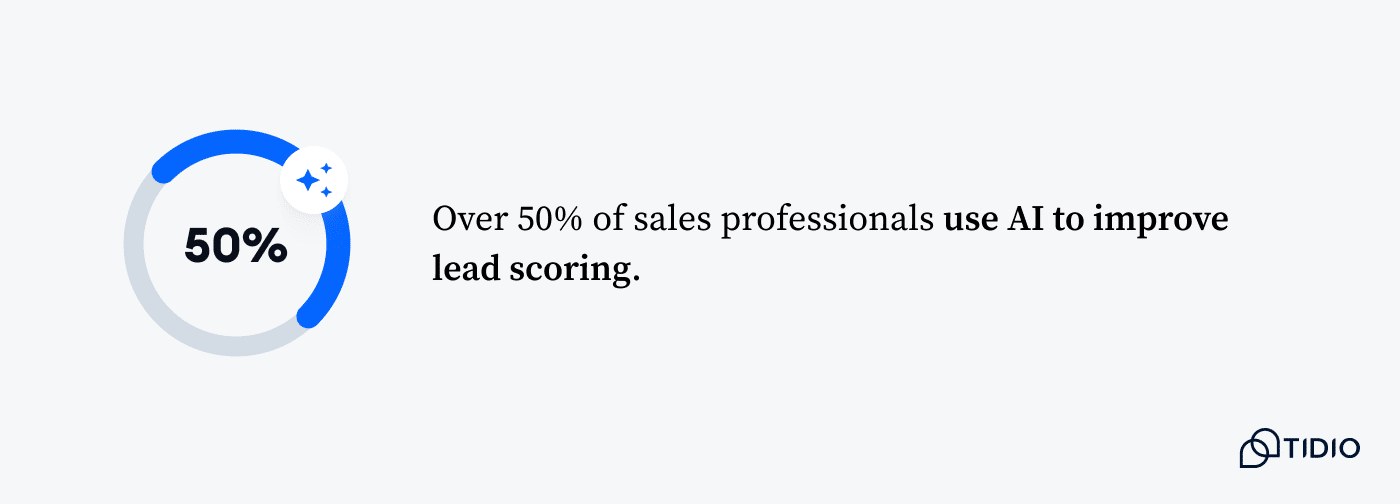
AI isn’t just a trend but a competitive edge. Used correctly, it cuts through noise and prioritizes the best leads. Moreover, it increases close rates without burning out your team.
HubSpot reports that 52% of sales professionals use AI to conduct data analysis, leveraging automated tools to inform decisions related to lead scoring.
You might be asking why now and why so many? Here’s why:
- Manual systems can’t scale personalization.
- AI aligns marketing and sales on what qualifies as a lead.
- It builds a revenue engine that improves with every interaction.
Now is the high time to start. And we recommend starting with these 4 simple steps:
1. Understand your sales funnel first
Before you dive into AI tools, take a step back and map out your sales funnel. Know all the stages, from the first time a lead visits your site to the moment a deal is closed. This helps you spot where AI can make the biggest difference.
2. Plug AI into your existing tools
Once you’ve mapped the funnel, it’s time to set up your tech stack. Your CRM, website, and email systems should all be ready for AI. Choose tools that can connect smoothly with what you already use. This way, your team doesn’t need to change how they work; AI simply makes their job easier.
3. Measure what matters
You can’t improve what you don’t measure. Focus on tracking a few key metrics. Look at your cost per lead (CPL), revenue per lead (RPL), lead-to-opportunity ratio, and how many marketing-qualified leads (MQLs) turn into sales-qualified leads (SQLs). These numbers show whether your AI tools are really helping you grow.
4. Test small, learn fast, improve often
Don’t go all in at once. Start small—maybe with just one channel or one campaign. Try A/B testing to see what works better. And when you analyse results, look at real outcomes like conversions, not just clicks or open rates. Use what you learn to tweak your approach and get better over time.
Implement AI lead generation with Lyro
If you want a fast, low-lift way to deploy AI in sales, Tidio and Lyro AI agent offer a full-stack solution for small and mid-sized businesses.
- Lyro: AI agent that captures, qualifies, and nurtures leads in real-time.
- Tidio: Customer experience platform that unifies live chat, automation, and lead management.
Why choose Tidio?
- It installs in minutes with no dev help needed
- Has prebuilt workflows for lead capture and qualification
- Offers seamless integrations with Shopify, WordPress, and major CRMs
- Works 24/7 without human supervision
Use it to replace static forms, reduce lead leakage, and drive more revenue, without increasing headcount.
Lyro will help you target better, act faster, and scale personalization in ways traditional tools never could. The businesses that will win in the next 12 months aren’t just using AI. They’re building systems around it.
You’ve got the framework. Now it’s time to put it to work.
Implement AI lead generation the right way with Tidio and Lyro

